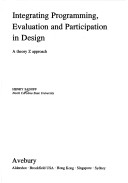Routledge Revivals
4 total works
First published in 1977, this volume was intended as a sourcebook for designers and attempts to specify the ingredients necessary to develop a design program rather than postulate a model program for which no consensus exists. As such it filled a void in the existing literature which seldom covered programming with much depth and provides technical aids to guide designers. The author attempts to integrate the pioneering contributions from others in order to identify the substance of programming for designers and represents a culling of the strategies and techniques from the social, behavioural and management sciences - building on the developing efforts of other disciplines.
Educators often overlook the positive impact of changing the environment of the school itself when considering how to improve the quality of education.
First published in 1994, School Design shows how to create more effective schools through a design process that involves teachers, students, parents, administrators, and architects. It reveals how to create school environments that develop the whole child, instil enthusiasm for learning, and encourage positive social relationships.
Readers discover how to integrate design research, design participation, and design development to optimize school settings. Using a number of case studies, detailed practical methods show how to:
- Link behavioural objectives to spatial needs
- Achieve spatial efficacy without compromising education
- Match children's developmental needs to facility requirements
- Promote greater variety in physical facilities to accommodate various teaching and learning styles
- Gain more valuable feedback from teachers, parents, students, and local citizens on building performance.
In response to tight school budgets, Henry Sanoff discusses how relatively minor design modifications can have a major positive effect on school performance. This path-breaking volume will provide architects, teachers, and school administrators with a wide array of insights into creating spaces that promote better learning.
Integrating Programming, Evaluation and Participation in Design
by Henry Sanoff
First published in 1992, this book is about making connections that may lead towards a new professionalism, since the past several decades have given rise mainly to new kinds of specialists in the areas of programming, evaluation, and participation. The implications for such integration are far reaching, with profound future effects on the physical environment, the design professions, and the education of designers. The book is split into four sections dealing with facility programming, several forms of evaluation, participatory design, and the application of Theory Z principles. This book will be of interest to students of architecture and design.
First published in 1991, this book is about applications and issues relating to the visual environment. The content pertains to the understanding of human behaviour in the environment by recording behaviour and actions or by direct interaction with people. The author examines research and planning methods that primarily stress the visual features of the physical environment. Traditionally, environmental research has relied on verbal descriptions and perceptions of the physical environment, virtually ignoring the visual component and the potential application of the social sciences for gathering this data. Various strategies that can expand the visual information base have been explored here: diagramming, photo-interviewing, photo-sorting, mapping, notation, simulation, videotaping, and CADD.



